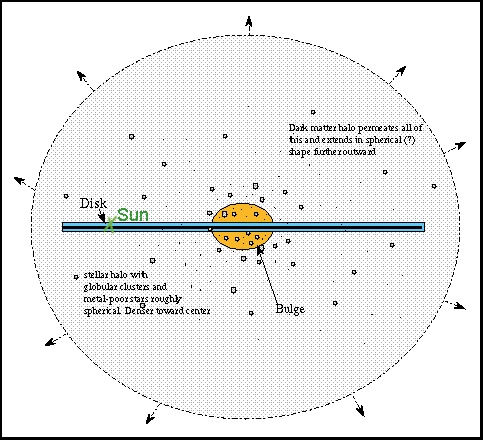
Here is a summary description of our Galaxy: the Milky Way. For a sense of scale, remember that 1 parsec = 3.26 light years and that the nearest star outside the solar system is about 1.3 parsecs away. A ``metal-rich'' star has a larger percentage of atoms that are heavier than helium. Since these heavier elements only come from stellar nucleosynthesis, a metal-rich star is made of material that came from a previous generation of stars. A metal-poor star is made of material that has undergone little if any processing. Generally, metal-poor stars tend to be older than metal-rich stars, though, alas, the correlation between metal-richness and age is poor! With this preface, here's the answer to the question:
What are the ``bulge'', ``stellar halo'', ``disk'', & ``dark matter halo'' of the Galaxy? Where are old metal-poor stars likely to be found? Where are young metal-rich stars likely to be found? How do you know the dark matter halo exists? Explain how it is known to be there! Using low-power binoculars, how could you determine that you live in a disk galaxy?

Answer: The components merge smoothly into each other with the stellar halo among the disk and the inner part of dark matter halo and the dark matter halo among the disk, stellar halo, and bulge, etc. The bulge is the elliptical-shaped center part of the Galaxy about 1000 to 2000 parsecs in radius. It had lots of star formation early on, so now it is made of tens of billions of old, metal-rich! stars.
The disk is the thin pancake-shaped part about 400 parsecs thick and 15 to 20 thousand parsecs in radius with the Sun 8000 parsecs from the center. The disk contains over 98% of the dust and gas in the Galaxy and has a few hundred billion stars. Some stars continue to form so the disk has some young metal-rich stars. The gas and dust are found in a layer that is thinner than the star layer (the gas/dust layer is the thin dark line at the midplane of the disk in the picture above and the star layer is the thicker light band).
The stellar halo is a roughly spherical distribution of hundreds of millions of old, metal-poor stars that has increasing concentration of stars toward the center of the galaxy. It is about 20 to 30 thousand parsecs in radius and it may contain small amount of hot gas, but the disk contains the vast majority. Most of the globular clusters are found in the halo and, like the halo stars, the number of them increases toward the galactic center. If the solar system was at the center, you would see approximately the same number of globular clusters in any direction you looked in the sky. Since the globulars are found bunched up in one part of the sky, i.e., they are swarming around some other point in the Galaxy, and we are not at the center. The dark matter halo is denser toward the center. It extends further out than the stellar halo.
The dark matter halo's presence is indicated from the rotation curve---a way to measure the amount of gravity inside a star's orbit, so that the mass inside the star's distance from the galactic center = (orbital speed)2 × (star's distance from the galactic center) / G. The rotation curve is flat even though the light-producing matter's distribution says it should be falling. The dark matter halo may go out as far as 60 to 80 (or more!) thousand parsecs! It is not known what the dark matter is made of (brown dwarfs, black holes, neutrinos with mass?).
Using binoculars you see a narrow band of stars (the ``Milky Way'') and a large number of gas/dust nebulae that are found only in disk galaxies or irregular galaxies. An irregular galaxy would have a much patchier distribution of material in various parts of the sky and would not produce the narrow band of stars. Only a disk galaxy would make the narrow band with a slight bulging in the direction of the galactic center. (For the Milky Way, the center is in the direction of the constellation Sagittarius.)
![]() Go back to previous section --
Go back to previous section --
![]() Go to next section
Go to next section
last updated: 25 May 2001